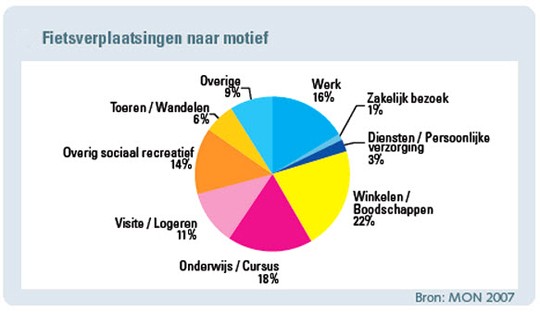
Prompted by a reader (via Twitter), I’ve been wondering why it is Australians seem far more likely to cycle to work and university than the local shopping centre, or to visit friends in their neighbourhood.
I don’t know the answer but it’s an interesting and important question so I’m prepared to offer some speculations.
Many of us are happy to cycle locally if it’s for sport or recreation, but other than commuting (about 100,000 of us cycled to work on Census day last year), we don’t cycle much for transport. That seems strange, because on the face of it cycling should be ideal for relatively short trips.
Our pattern of cycling is very different to the Dutch model. More women cycle than men in the Netherlands and both sexes keep riding well into their seventies.
They travel in street clothes on built-for-comfort bikes. Cycling is primarily a form of transport rather than a sport or recreation.
It’s the mode of choice for local trips in much the same way as we use cars. Most trips are short and, importantly, bicycles are used for a wide range of purposes including shopping, taking children to school and visiting friends.
In fact commutes only make up 16% of all cycle trips in the Netherlands according to David Hembrow. I don’t have any reliable numbers to hand on the extent to which Australians cycle locally, but I’m pretty confident it’s a lot lower than the proportion who cycle to work and university.
There are doubtless any number of reasons why we don’t cycle much to the shops or the doctor. We worry about the bike getting stolen, adverse weather, or how to fit the groceries for a household of four on the bike. Yet as the Dutch show, there are solutions to these problems.
My conjecture is there are two key reasons why we tend not to cycle locally. One is the perception it’s unsafe and the other is the fact we have easy access to a car.
Unlike the Netherlands, we don’t have decent cycling infrastructure (yet) and we don’t have drivers who look out for cyclists. We don’t have what David Hembrow calls a strong sense of “subjective safety”.
Moreover, the great majority of households in Australia have at least one car. In Melbourne, for example, it’s around 90%, so it’s easy enough for most adults to plump for subjective safety and drive to local destinations.
Traffic congestion isn’t as significant a deterrent to driving for local trips as it is for peak hour commuting. More than 90% of capital city residents live in the suburbs and most non-work and non-education trips have a degree of flexibility in timing.
The Dutch experience shows it’s perfectly possible to fetch groceries and take multiple children to school or kinder by bicycle, but it requires good infrastructure. And cyclists have to be convinced drivers are sympathetic.
Of course it helps that car ownership rates in high-cycling areas of the Netherlands are much lower than they are in our suburbs (63% of Amsterdam households have no car compared to 14% in Sydney). That’s no doubt largely the result of a ‘virtuous cycle’.
On the other hand, although very few Australians cycle to work – cycling’s mode share in capital cities is around 1% – we appear much more inclined to do it than pedal to local destinations (excluding cycling for sport or recreational purposes).
Perhaps that’s because there’s more cycling infrastructure serving work places than shopping centres or parks. As most cycling commutes are in and around the city centre, there might be something to that.
Or maybe it’s because commuters travel regularly between the same origin and destination. They can drop a change of clothes off at the office each week, park their bikes in a secure area, and even leave their heavy D Locks on the office bike rack. They can amplify their exercise reward from cycling because many employers provide change rooms and showers.
These factors are probably somewhere in the mix but I don’t think they’re the key explanation. My conjecture is the main reason is public transport. Most commuters who cycle wouldn’t otherwise drive – they’d use public transport.
In Australian cities, public transport is often over-crowded in peak hour and unreliable. For those workers prepared to “risk it” in traffic – and they’re disproportionately young men – cycling to work offers many of the advantages of driving.
Unlike trains or buses, there’s no waiting, no stopping, no circuitous routes, and no sharing. Moreover, cycling is flexible – it’s possible to thread through traffic and take to the footpath to get around obstacles.
Even with the inevitable punctures, it’s more reliable than late or cancelled public transport services. Like driving and walking, cycling is an inherently private mode of transport.
All of this is motivation for those who David Hembrow describes as mostly “self-selected confident young adults” to cycle to work. However if the sense of subjective safety can be increased by strategic infrastructure investments on key commuting routes, particularly to the city centre, it’s likely the already very high growth rates (albeit from a small base) can be increased.
That’ll be hard enough, but growing a Dutch-style cycling culture of significant scale at the local level will be even harder. Some progress has been made in rendering parts of the inner city more amenable for local cycling, but Australia’s overwhelmingly suburban cities are still a long way behind their counterparts in the Netherlands.
Progress will require big investments in infrastructure and changes in the attitude of drivers. But I suspect the biggest constraint on Australians taking up “cycling to the shops” in significant numbers is the ease of driving.
As I said at the start, I’m speculating here: there’s not enough information about cycling to be definitive. Even so, I’ll stick by my earlier claim that “the journey to work is one of the most promising purposes for cycling as a means of transport.” In the short to medium term anyway.








Crikey is committed to hosting lively discussions. Help us keep the conversation useful, interesting and welcoming. We aim to publish comments quickly in the interest of promoting robust conversation, but we’re a small team and we deploy filters to protect against legal risk. Occasionally your comment may be held up while we review, but we’re working as fast as we can to keep the conversation rolling.
The Crikey comment section is members-only content. Please subscribe to leave a comment.
The Crikey comment section is members-only content. Please login to leave a comment.